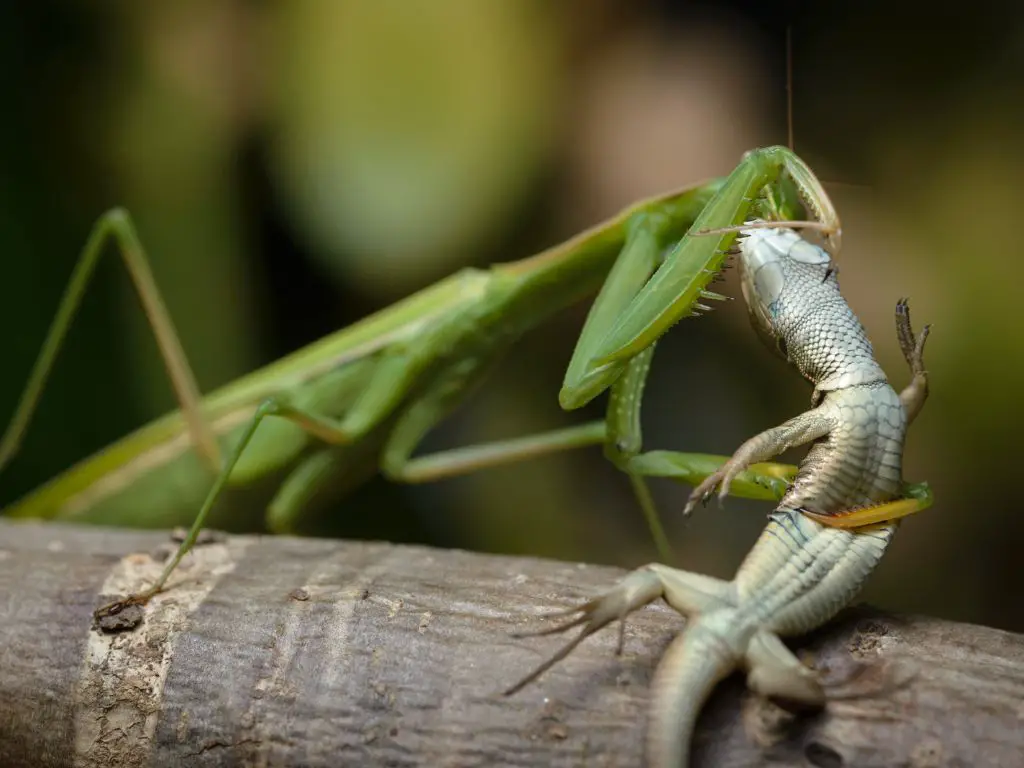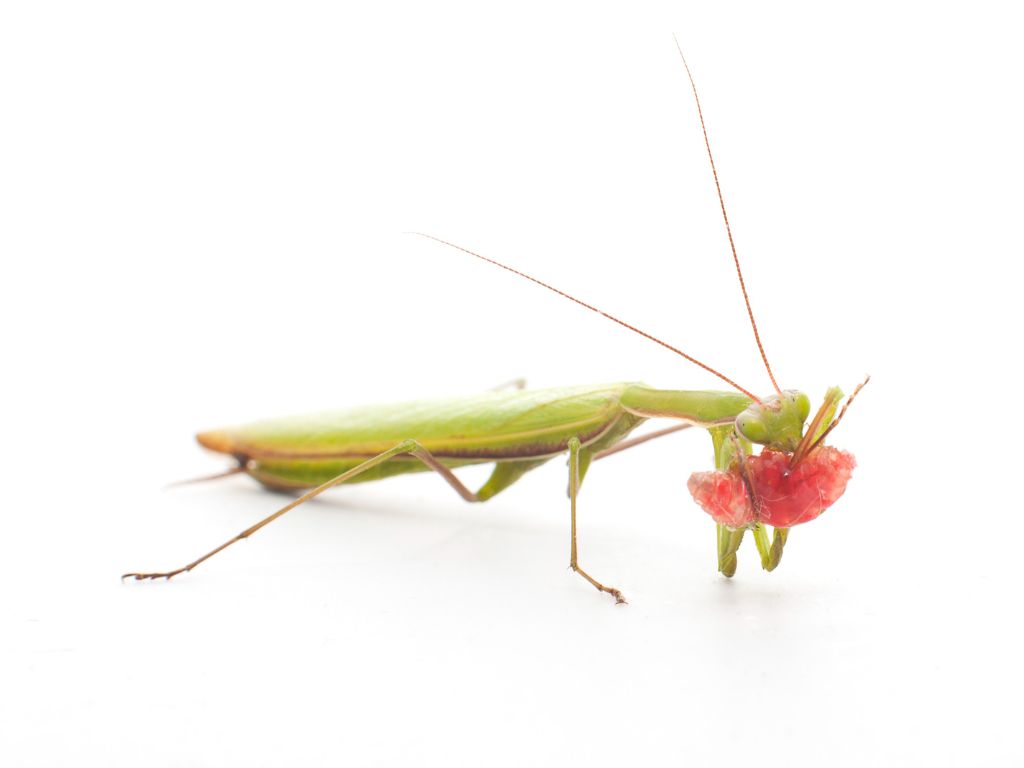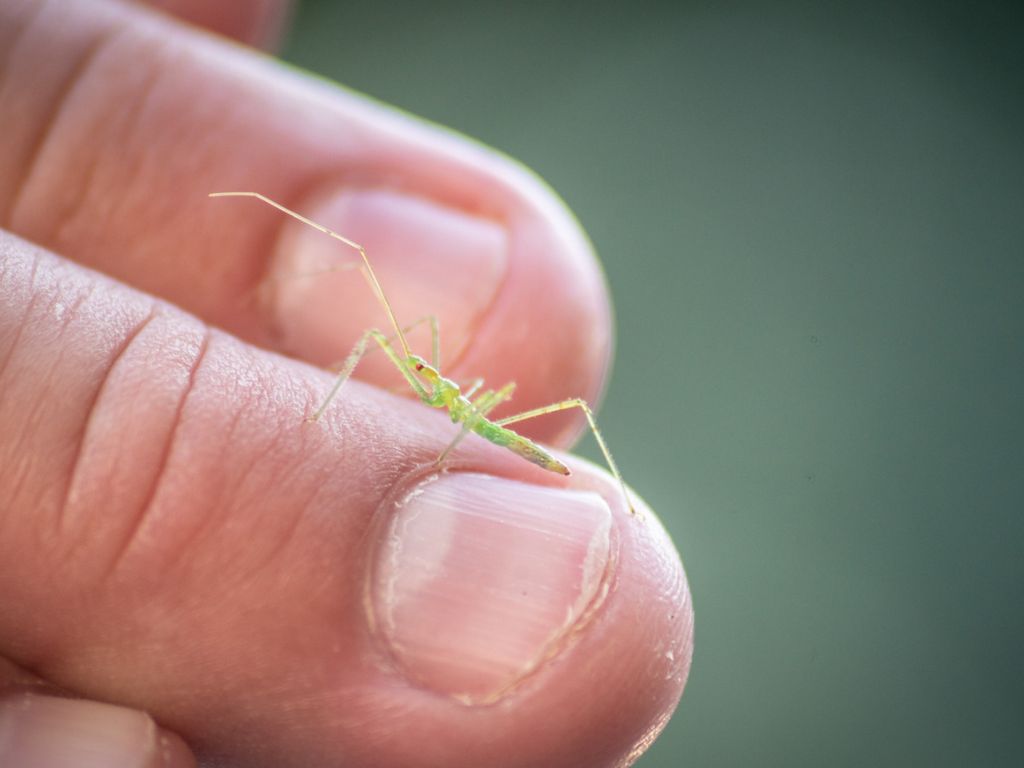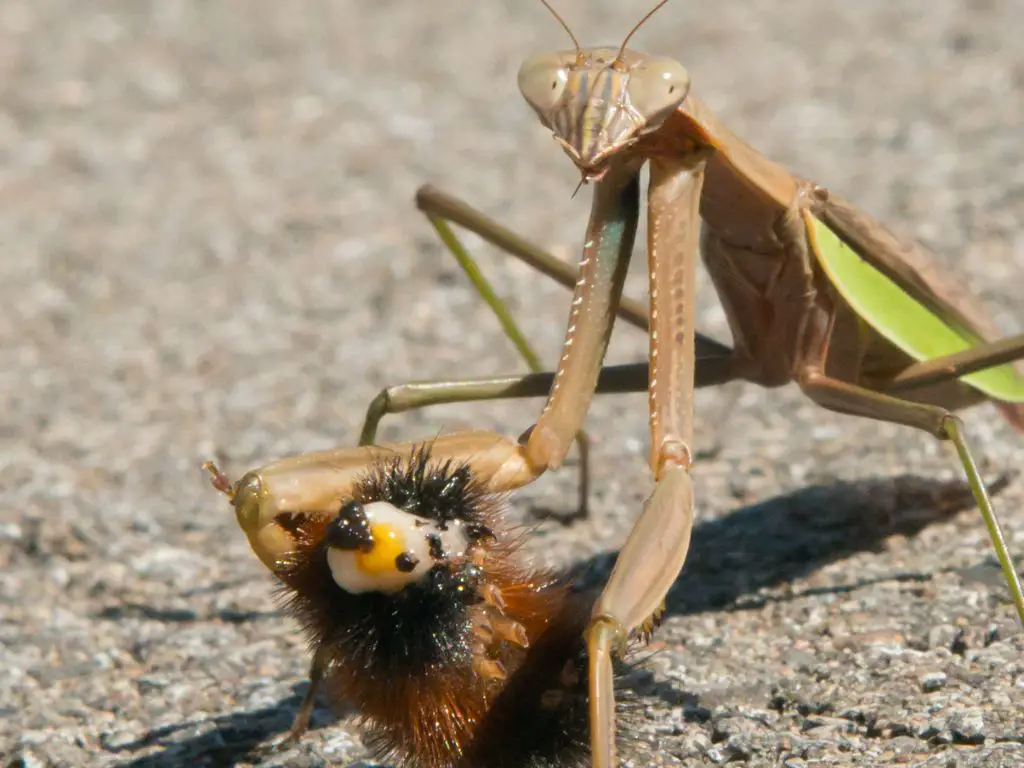Praying mantises are ambush predators that use their powerful front legs to grab and hold onto their prey while they feed. They are also known to use their camouflage and cryptic behavior to remain undetected by their prey until it is too late. It is well know for eating its mate after or during copulation. Lets find out more about Praying Mantis Diet and What Do Praying Mantis Eat both in the wild and in captivity. At the end of this article we will reveal why do praying mantis eat their mate.
What Do Praying Mantis Eat
Praying mantises are carnivorous insects that primarily feed on other insects and arthropods. Some species of praying mantises may also occasionally consume small vertebrates such as lizards, frogs, and birds. They are known for their predatory behavior and their ability to catch and consume prey that is much larger than themselves.

What do praying mantis eat in the garden
Here is a list of common prey items that praying mantises may consume:
- Flies
- Beetles
- Cicadas
- Grasshoppers
- Crickets
- Spiders
- Moths
- Butterfly larvae

In addition to insects and arthropods, praying mantises may also feed on small vertebrates, such as lizards and birds. However, these animals are not a regular part of their diet and are only occasionally consumed if they happen to be in close proximity to the praying mantis.
Praying mantises are opportunistic predators and will eat whatever prey they can catch and subdue. They use their strong front legs to grasp and hold onto their prey while they use their mandibles (jaws) to bite and tear off pieces of their food.

Overall, the diet of a praying mantis is varied and can include a wide range of insects and other arthropods, as well as occasional small vertebrates.
What do praying mantis eat in captivity
In captivity, praying mantises can be fed a variety of insects and other arthropods as a source of nutrition. Some common prey items that can be offered to praying mantises in captivity include:
-
Crickets:
These are a popular and easily obtainable food source for praying mantises. They can be purchased from pet stores or online retailers and can be gut-loaded (fed a nutritious diet) before being offered to the praying mantis.
-
Mealworms:
These are the larvae of the mealworm beetle and are another commonly offered food for praying mantises in captivity. They can be purchased in various stages of development and can be kept in a container with a substrate (such as oats or bran) to provide them with food and moisture.
-
Flies:
House flies, fruit flies, and other small fly species can be offered to praying mantises as a source of food. These can be purchased online or collected from the wild (if legal in your area).
-
Moths:
Moths, especially those in the early stages of development (such as caterpillars), can also be offered to praying mantises as a food source.

It’s important to note that praying mantises should only be offered food that is appropriate for their size and stage of development. Smaller praying mantises will not be able to consume larger prey items, and it is important to ensure that the prey is not toxic or harmful to the praying mantis. It is also important to provide a varied diet to ensure that the praying mantis receives a balanced nutrition.
What do baby praying mantis eat
Baby praying mantises, also known as nymphs, have a similar diet to adult praying mantises and feed on a variety of insects and other arthropods. As they grow and develop, they will be able to consume larger prey items.
In the early stages of life, baby praying mantises may feed on smaller insects, such as:
- aphids,
- mites,
- and small flies.
As they grow and mature, they will be able to consume larger insects and arthropods, such as:
- crickets,
- mealworms,
- and moths.

It is important to provide baby praying mantises with a varied diet to ensure that they receive a balanced nutrition. It is also important to only offer prey that is appropriate for their size and stage of development, as smaller praying mantises may not be able to consume larger prey items.
It is also important to ensure that the prey is not toxic or harmful to the praying mantis, and to provide a clean and safe environment for the praying mantis to live and feed in.
How often do praying mantis eat
The frequency of feeding for a praying mantis will depend on its age, size, and the availability of prey in its environment. In general, adult praying mantises will require less frequent feeding than nymphs (baby praying mantises) due to their larger size and slower metabolism.
Nymphs may need to feed more frequently, as they are growing and developing and require a constant source of nutrition. In the wild, nymphs may feed on a variety of insects and other arthropods, such as aphids, mites, and small flies. As they grow and mature, they will be able to consume larger prey items.

In captivity, the frequency of feeding for a praying mantis will depend on the availability of prey and the size of the praying mantis.
- Adult praying mantises may require food once every few days,
- while nymphs may need to be fed daily or every other day.
It is important to provide a varied diet and to only offer prey that is appropriate for the size and stage of development of the praying mantis.
Do praying mantis eat plants and fruit
In general, praying mantises do not feed on plants and do not play a significant role in plant nutrition or pest control. However, some species of praying mantises may occasionally consume nectar or other plant fluids, particularly in the absence of other food sources.

It is important to note that the diet of a praying mantis is highly variable and can vary depending on the species and the availability of prey in their environment.
Why do praying mantis eat their mate
Praying mantises are known for their predatory behavior, and in some cases, females may consume their mate after or during copulation. This behavior, known as sexual cannibalism, has been observed in some species of praying mantises and is thought to be influenced by a variety of factors, including the availability of food and the size and condition of the male.

One theory for why some females may engage in sexual cannibalism is that:
- it provides them with a nutritional benefit,
- The male’s body may provide the female with additional energy and nutrients that can be used to support her reproductive efforts, such as egg production.
- It is also thought that sexual cannibalism may be a way for females to reduce the risk of predation by other animals, as the presence of the male may attract predators. Consuming the male after copulation may reduce the risk of attracting additional predators.
It is important to note that sexual cannibalism is not observed in all species of praying mantises, and the specific reasons for this behavior may vary between species.
<iframe width=”560″ height=”315″ src=”https://www.youtube.com/embed/Hwh7vwyrhc0?si=kFydH-vpVZb26csv” title=”YouTube video player” frameborder=”0″ allow=”accelerometer; autoplay; clipboard-write; encrypted-media; gyroscope; picture-in-picture; web-share” referrerpolicy=”strict-origin-when-cross-origin” allowfullscreen></iframe>


Leave a Reply